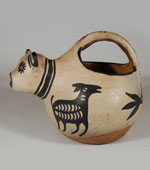Special Exhibit opens today! Cochiti Pueblo Figurative Pottery
Special Exhibit opened this evening (cick here to view the show now!) A collection of Cochiti Pueblo storytellers, nacimientos (nativity scenes), and other figurines from Pueblo potters of the past few decades.
An example figurine is shown left. Although we don't know who made this figurine, we do know it was a Cochiti Pueblo woman. For more information on this specific figurine, click here to view now: Historic Cochiti Pueblo Effigy Pitcher with Animal Head
Title: Zuni Pueblo Polychrome 19th Century Olla
The interior of the neck of this large magnificent jar is painted black with a narrow band that is left in the matte state, not polished. It has been noticed that jars with narrow black bands inside the rim tend to be earlier than jars with wider bands. This is a distinctive trait of Zuni Polychrome jars starting around 1870.
The bottom area of the jar is painted the traditional black that was transitioned from the previous red underbodies starting as early as 1850 and approaching completion around the late 1890s.
The predominately rounded shape of the jar is typical of Zuni Polychrome jars of the 1870-1880 periods. At the same time, the strong puki flexure that existed in the Kiapkwa periods is noticeably lessened on this jar but is still evident to the touch, something noted starting around 1870.
The design layout on this jar is typical of that which began in the 1870s, which is inclusion of a beautifully executed neck design with the main body design being divided horizontally by a band of birds encircling the mid-body of the jar. The previous use of a vertical rectangular design being used as dividing the mid-body was replaced by a beautifully large rosette or medallion at this time. These rosettes appeared around 1870. They have been attributed to Spanish rosettes carved into furniture or to the sunflower painting on the Zuni Salimopiya Katsina face.
The main body design features large capped spirals above and below the band of small red birds that originated in the pre-1850 periods but continues even to today. They have sometimes been called volute elements.
Based on information above, it is determined that this magnificent jar was made in the period around 1880, possibly as early as the 1870s.
The information presented here is derived from the inclusive 600-page book published in 2008 exclusively on the pottery of Zuni Pueblo by Dwight Lanmon and Francis Harlow. This is a comprehensive study of Zuni pottery and is an invaluable research resource. It is from such research that it is now easier to estimate the date a specific vessel was made.
Condition: When the jar arrived at Adobe Gallery, we noticed two hairline cracks from the rim running vertically down the body of the vessel on opposing sides. We had the cracks professionally stabilized to prevent further damage. There is no other damage or repair to our knowledge.
Title: Zuni Pueblo Polychrome 19th Century Olla
Potter Unknown
Category: Historic
Origin: Zuni Pueblo
Medium: Native Materials
Size: 11" tall x 15-1/8" diameter
Item # C3122
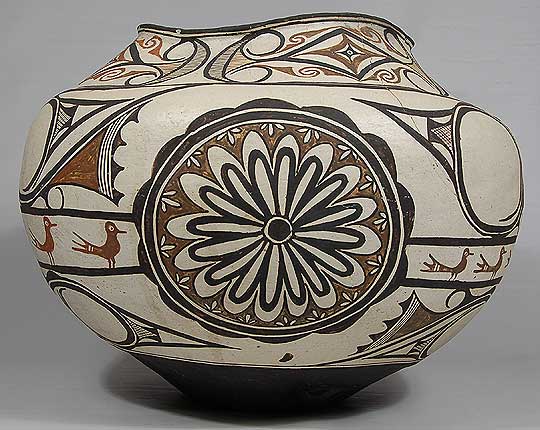
Happy Valentine's Day
Things are looking a lot like Valentine's Day around Adobe Gallery.
Do you need some ideas for a Valentine gift?
Take a look at our jewelry for starters (click here to view now).
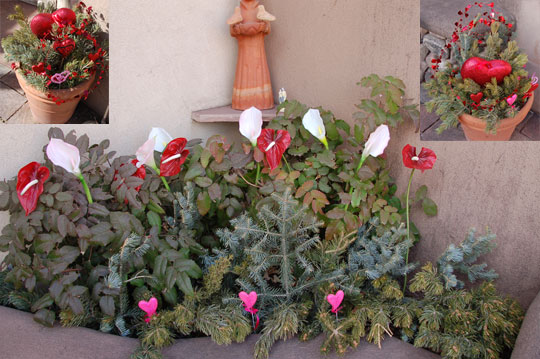
Adobe Gallery is an Annual Canyon Road Holiday Decorating Contest Winner 2011!
Congratulations to the winners of the Annual Canyon Road Holiday Decorating Contest.!
While holiday décor is still blossoming over much of Santa Fe, Canyon Road is already in full bloom. Holiday spirit bursts from every entrance, inviting visitors to celebrate the season along this magical stroll through a local Winter Wonderland.
In light of all the beauty from the galleries and stores that line Canyon Road, it is no wonder that Simon Brackley from Santa Fe's Chamber of Commerce had a difficult time judging this year's Holiday Decorating Contest. He said that Canyon Road had the best decorations that he had seen on the road, ever. Adding to the décor was the spirit that fills the road, with many businesses serving hot cider, hot chocolate and cookies to visitors during the day.
After seeing so much holiday spirit on Canyon Road, Simon and the Canyon Road Merchants Association were honored to name the winners of the Holiday Decorating Contest during the First Annual Canyon Road Merchant Association Holiday Party at Ventana Gallery on the evening of December 14. While all of the decorations were stunning, three businesses stood out.
Without further adieu, [on of] the winners of this year's Holiday Decorating Contest: Runner UP: Adobe Gallery - If ever a place seemed as if it should be featured on a holiday card, then Adobe Galley would be that place. Owned by Alexander E. Anthony, Jr., this gallery features a stunning front entrance. Wreaths and greens, Red Berries, Holiday Ribbon adorn the entrance, and the lights at night only add an additional touch of sparkle, making the Adobe Gallery a place that you don't want to miss.
Congratulations to [the] winners, and to all of the participants along Canyon Road, for enriching everybody's lives with the Magic of the Holidays. We hope that everybody has a chance to not only stroll Canyon Road and see these amazing displays firsthand, but also take the time to see all of the other fabulous decorations from our merchants.
Happy Holidays from all of us at the Canyon Road Merchants Association.
(photo courtesy Canyon Road Merchants Association)
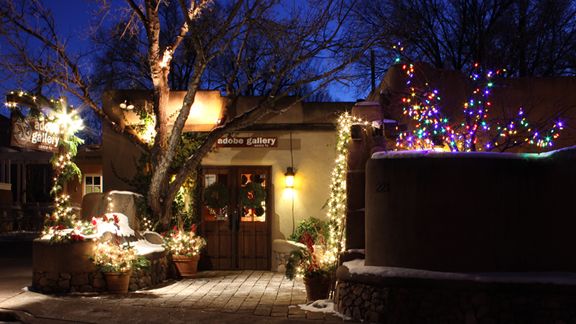
Biography: Quincy Tahoma, Diné-Navajo (1920-1956)
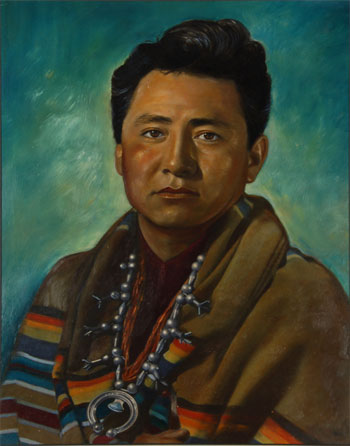
Quincy Tahoma 1917-1956 Water Edge (click here to view his biography now)
It was while at Santa Fe Indian School, Quincy Tahoma developed his unique painting style. After WWII, he established himself as a full-time artist and painted a wide variety of subject matter but was perhaps best known for his dynamic action filled paintings. He also painted pictures full of humor.
His signature included a vignette, a miniature scene which depicted what happened after the action in the painting (Lester 1995).
Quincy Tahoma died a tragic accidental death at a very young age. He was only 39 years old.
A Visit from Robert Tenorio
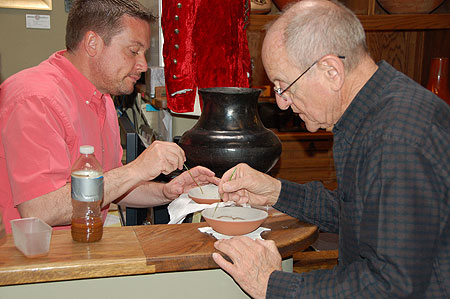
Several weeks ago Robert Tenorio, a well known potter of Kewa Pueblo (Santo Domingo), paid us a visit here at Adobe Gallery as he does from time to time. On this particular occasion, however, Tenorio came bearing a once in a lifetime gift only offered to a small number of people outside the pueblos.
He pulled, from a grocery size paper bag, several plastic containers full of various colors of clay slips, yucca brushes that had been chewed at the tip, and four pre-fired pottery items. One large water jar that he (Robert Tenorio) was working on and three smaller bowl shaped vessels. He laid all four pottery items on the counter around Al's desk and began painting his pot.
"Well..." he said, as the three of us stood there in awe of what we were witnessing. "Paint!" Al and Todd were being offered the opportunity to paint their own bowls made by Robert Tenorio himself! Al immediately painted a flower as if he had decided long ago what he would do if he had ever been given the opportunity. Todd took a little more time to think about what to paint. (Comment about what design you would have painted!)
Robert Tenorio took the four pots home, fired them, and returned them to us the following week. He gave them to us as gifts. Robert told us to pat egg whites around the bowls something, at first, that we didn't understand, but, after seeing them, it left the bowls with a shiny coat almost as if they had patina; the egg whites may also serve a protective purpose.
Pictures of the process and finished product have been posted in our Facebook photo gallery if you have an interest to take a look.
It was an incredible experience that we are humbled and excited to have partaken in.
We were curious, too, if you knew of another reason for coating the bowls in egg whites we are interested in your thoughts.
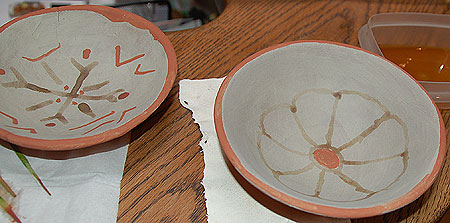
Katsina Collection
Katsinas are pueblo religious figures that represent anything relating to the natural world or the cosmos. Male members of the Pueblo may dress up as a particular katsina during religious ceremonies out of respect for the katsina, and their powers (i.e. bringing rainfall, protection, or fertility). Katsina dolls are given twice a year, every year, to the girls of the pueblos and though every pueblo maintains these traditions only the dolls of Hopi pueblo, and occasionally Zuni, are given away or sold, outside of the pueblo itself.
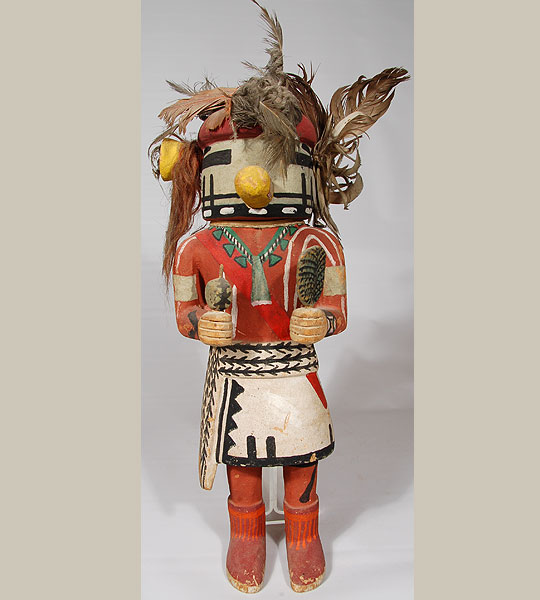
We have received, and have recently posted, 18 katsina dolls to the website; 17 from Hopi Pueblo and the last from Zuni Pueblo. All 18 of the katsinas are from a single collection and were either purchased or given as gifts by the original owner in 1959 or 1960. The collector made several visits to Hopi Villages to witness various katsina dances during this time period. They were all once the property of young girls given, in tradition, during the religious ceremonies.
By going to the home page of our website and clicking on special exhibits and shows you will find a show created specifically for this collection (as long as it remains active).
Let us know what you think of the dolls and which of them might catch your eye and why?
AL Anthony Interviewed by Stephanie Tafoya
The following is an interview of AL Anthony by Stephanie Tafoya, a great granddaughter of Margaret Tafoya on Tuesday, May 31, 2011:
Dear Mr. Anthony,
My name is Stephanie Tafoya, and I'm currently a student at the Fashion Institute of Design & Merchandising in Los Angeles, CA. I selected you for an informational interview as a class assignment because I admire you and your gallery, as I see you hold numerous pieces from my great grandmother Margaret Tafoya and her children after, and also have been a trusted gallery in Northern New Mexico for many years. I am interested in hearing your point of view about the Santa Fe Art Industry and have prepared eight questions if you would be ever so gracious to take time out of your busy schedule to answer, I would greatly appreciate it. I have included the questions below, and can be reached by email at: [email address hidden]. Thank you for your time.
-Stephanie Tafoya
To: STEPHANIE TAFOYA
1. What do you find most interesting about Southwest Indian Pueblo pottery and fine art to acquire such a collection over the years?
Response: I find that even though the process for making pottery is so laborious and time consuming, the potters have continued the original process even into the 20th century when much easier techniques could be used. I appreciate the determination to stick to tradition regardless of the work involved. I have always been impressed that potters a couple hundred years ago, and even earlier, would spend so much time decoration daily utilitarian vessels that were for their own use. It demonstrates their love of beauty and their determination to have such beauty around in their daily lives.
2. What is your decision process when selecting items to sell in your gallery?
Response: I select only items that are authentic to each pueblo or tribe and that are made in the traditional manner. Condition is important on contemporary pottery but not so much on historic ones that exhibit use as utilitarian wares.
3. What have you found most fulfilling in your career as a successful art dealer?
Response: It gives me much pleasure to be surrounded by beautiful objects daily and to be able to explain the importance of such items to potential collectors. I truly take pleasure in helping clients build a meaningful collection and learn about the importance (tradition, history, beauty) of each object. This knowledge helps them in the selection process as each collection is unique to each individual collector's taste and budget.
4. Have these rough economic times had an effect on purchases made by consumers? If so, what has your gallery done to survive in the art market?
Response: Sales were off in 2009, picked up somewhat in 2010 and have been back to normal for us (so far) in 2011. We have been more actively marketing through our website. This effort seems to have been successful for us as we are seeing about 85-90% sales through the website. As a result, we have invested and launched a brand new website just last week. Our goal was to create a website that showcases the beauty of each art object.
5. Being that there are over 100 galleries located on Canyon Road, what do you do to set yourself a part from your competition?
Response: We do not wait for walk-in clients to come to the gallery. We actively market our inventory on a daily basis by sending emails every morning (1am MST) on those items that are new acquisitions and that the client is interested in (target marketing). Oftentimes, these items are sold (or have several clients interested in) by the time I wake up in the morning.
6. How is your gallery keeping up with trends, such as social media, phone applications, and other technological advances?
Response: We maintain and build relationships with clients via personal phone calls and snail mail (post cards, etc.), most of our clientele are familiar with this means of correspondence; however, in addition to these traditional forms of advertising we are always wanting to learn and utilize social media to the best of our, and its, ability. Recently we attended a local workshop designed to introduce small businesses to the benefits of social media (such as Facebook, Twitter, LinkedIN, and Blogging); we have connected our Twitter account to our newly developed Facebook Fan Page, as a result. You can also find us on YouTube-we have a four minute video clip of the gallery that is paired with an aria from the final act of Giacomo Puccini's opera Turandot. You can find us throughout the internet, in sites such as ATADA (Antique Tribal Art Dealers Association).com and SantaFean.com (a site for Banner Advertising), as a reference tool. A large majority of our business is actually done online, via our website.... On March 18th, 2011 we launched a brand new site that also includes a blog for two-way communication between us and our members. With the site we are able to do Target Marketing, a tool that allows us to send a daily email to our members who have expressed an interest in a particular artists, category, or pueblo; they are then capable of responding to these emails as an inquiry about an item and close a sale all with the click of a mouse.
7. As you know, Santa Fe, NM is one of the top tourist attractions and the second largest art market in the nation. Do you see any expansion in the future where Santa Fe could possibly be number one?
Response: As much as I would love to see Santa Fe become number one, I seriously doubt that we will ever overtake New York City. New York has traditionally been the home of fine art galleries and major auction houses and that will keep it as number one in the foreseeable future.
8. What advice can you give young artists trying to make their name in the art market?
Response: I would encourage ANY artist, regardless of age, to:
• Develop a web site of their own and actively promote their art through it
• Take the time to describe each piece and what the viewer should be looking for or see.
• Always update your website and add new content and correct any mistakes.
• Develop a Facebook FAN page and keep it updated.
• Tweet with Twitter about what's going on, every day.
• Join and network with other artists and galleries using sites such as LinkedIN.
-Alexander E. Anthony, Jr.
Stay Connected with Adobe Gallery
Connect with us! Adobe Gallery is reaching collectors in several new and innovative ways.

Re-Designed Website and the Adobe Gallery Blog - Our site has been rebuilt from the ground up. In doing so, we added a blog. You can now connect with our staff and other collectors about all things Adobe Gallery. Read, comment, or even create your own subject.
Facebook Adobe Gallery's Facebook Page - Like us on Facebook and see what's happening in the gallery. It's real-time and relevant. See what others are commenting on and interested in. See what's coming into the gallery and what's selling. Click here to see.
Twitter Adobe Gallery's Twitter Page - We’ve got potent amounts of information about the gallery in just 144 characters (tweets). Send us a tweet: @adobegallery
YouTube YouTube - Watch our videos of gallery inventory and more. Watch here.
Pinterest Pinterest - View pins of objects that we have/had in our inventory. Take a look.
New Book - Quincy Tahoma: The Life and Legacy of a Navajo Artist
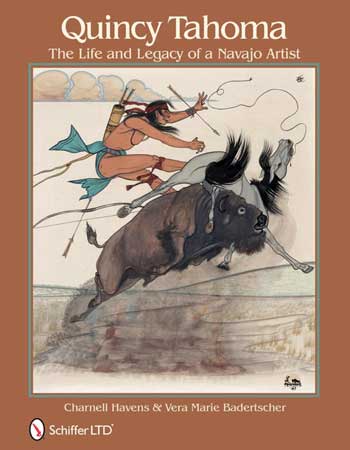 Quincy Tahoma was a Diné (Navajo) artist who attended the Santa Fe Indian Art School in the 1930s instructed under Dorothy Dunn--the founder of the art program at the Indian School. Even though he died when he was very young, he was still responsible for some of the most important art of the time.
Quincy Tahoma was a Diné (Navajo) artist who attended the Santa Fe Indian Art School in the 1930s instructed under Dorothy Dunn--the founder of the art program at the Indian School. Even though he died when he was very young, he was still responsible for some of the most important art of the time.
Clara Lee Tanner believed him to be "...one of the most dynamic, imaginative, and gifted of the Southwest artists." Tahoma painted in a very unique and recognizable style, and later on in his life his paintings began to take on more violent subject matter depicting action scenes of various animals hunting in very real and sometimes haunting ways.
Quincy Tahoma quickly became a favorite of mine earlier this year when I was first welcomed to the gallery. We had three hanging on the walls that stole the attention of most paintings sharing the room. Though his life was sometimes enveloped in misfortune and his death most definitely was he inspired and has influenced, and still does today, many artists and enthusiasts alike.
In mid April of 2011 a book ten years in the making on Tahoma was released, Quincy Tahoma: The Life and Legacy of a Navajo Artist by Charnell Havens and Vera Marie Badertscher, and on August 18th, 2011, we held a book signing and art show opening dedicated to the book and works of Quincy Tahoma.
We look forward to hearing your thoughts on Tahoma and sharing in your excitement of the coming Show. Let us know what you think.
Quincy Tahoma Biography and Artwork currently available from Adobe Gallery (click here to view now).
Western Art Collector Magazine Article
Adobe Gallery has a full page article in the May issue of Western Art Collector Magazine. If you have not yet read it, we recommend that you do so. Alexander Anthony was quoted in this article describing the state of the Indian Art Market during this economy. He said, "Sales are strong and outstanding...art objects are coming on the market from collections throughout the country."
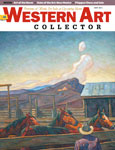
And so, despite the current economy, Native American Pottery and paintings remain an interest and are in high demand by collectors around the globe. Mr. Anthony began the interview explaining that "there is a very strong market today for classic Pueblo pottery and paintings as well as non-Indian art."
The article was intended to introduce Alexander Anthony (and Adobe Gallery) to anyone who may not yet be familiar with him. This exposure also serves to enlighten readers of Western Art Collector Magazine of Adobe Gallery's book signing and special exhibit which opens on August 18th in honor of the publication of Quincy Tahoma: The Life and Legacy of a Navajo Artist. This special exhibit will continue through September 20th.
Please, if you have questions, comments, or suggestions feel free to make them known in our comment block just below this blog.
The new look of Adobe Gallery!
We launched our new website in April 2011-several years in the making. We hope you enjoy scrolling through our enhanced web pages and photographs. It should take you less time to find what you are looking for. We work hard to bring you as much information about each item and artist, and this takes time to research. No other gallery in our market does this for you.
Also included with this new website is the ability to communicate with us in a new way. In addition to traditional methods, you can now share your thoughts, ideas, suggestions and enthusiasm with us, with your friends, and with your fellow art enthusiasts--right here in our blog.
Please take a few minutes to browse the new site. We look forward to sharing information and knowledge with you. Please comment, create your own blog subject, or just let us know what you are thinking.


